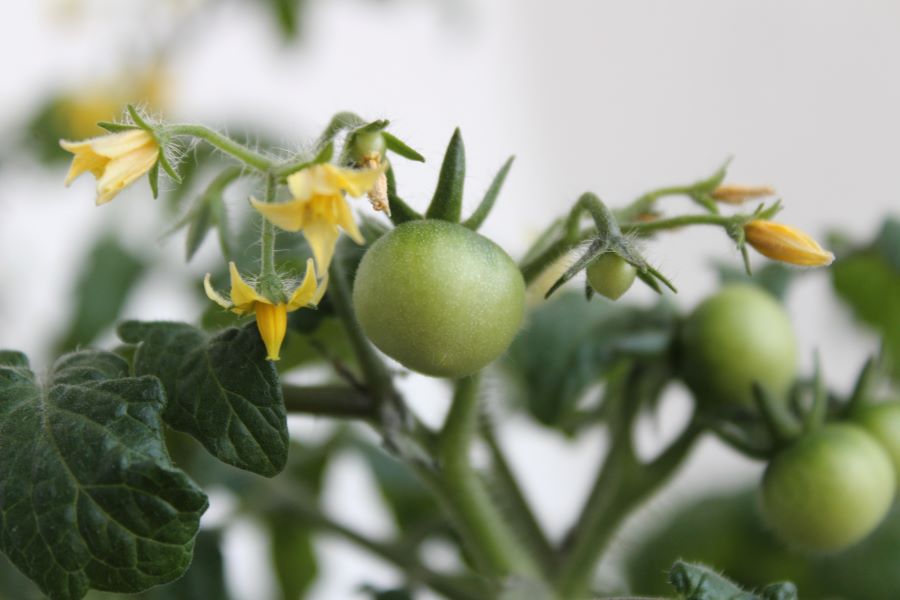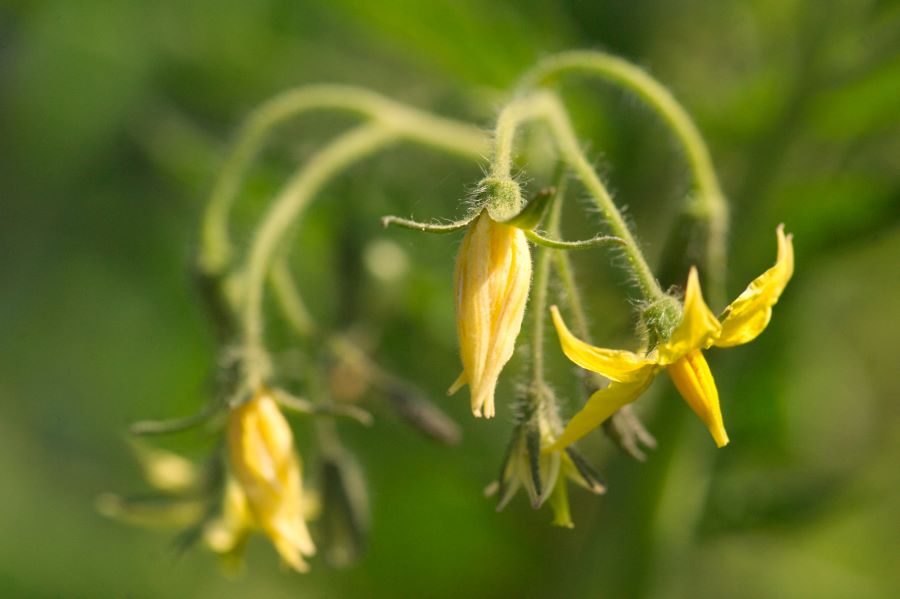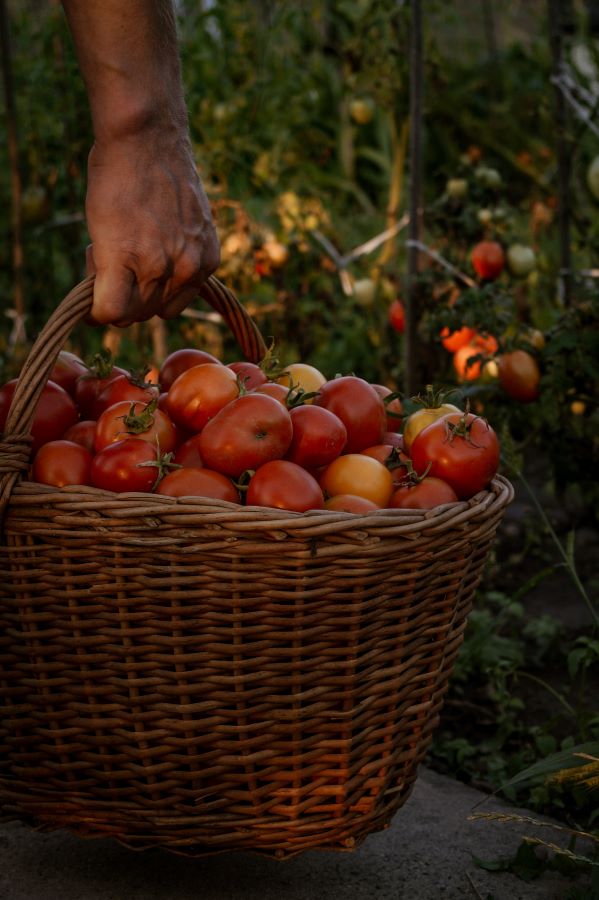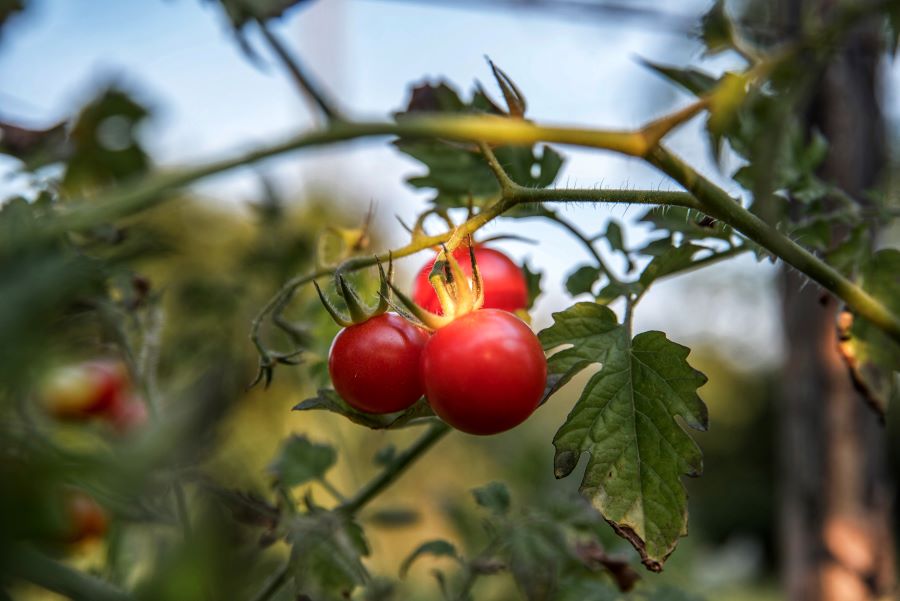It happens a lot. We grow and nurture our tomato plants, but sometimes we get no fruit. The flowers appear and after several days they wither and drop off…leaving no tiny tomatoes behind.
What causes this? You may be thinking you’re doing something wrong. The answers are quite simple. But the solution may be a bit difficult.
Here are some answers that explain what’s going on when blossom drop happens. And also some strategies you can take to help you get your tomatoes.

But let’s first remind ourselves how tomato pollination occurs. Tomato flowers are self-fertile, meaning that the pollen from one flower can pollinate itself to yield fruit. No need for another tomato plant.
The male part has the anthers with pollen at the end, and the female part has the stigma which receives the pollen. The tiny pollen grains land on the stigma, which is sticky to catch and hold the pollen. The pollen grains then grow down to the ovule to fertilize it. There starts your tomato.
This happens fairly easily on its own in tomatoes in good conditions. But two factors do help it. One is wind and the other is bees, but only certain bees— several species of bumble bees.
Increase the chances of pollination
Our summers often have nice breezes each day. A wind or a breeze rattles the flower and shakes the pollen off the anthers so there’s a good chance enough of them land on the stigma for good pollination.
Insects can help pollinate tomatoes, too. Tomato flowers don’t produce any nectar, but they do produce pollen. That rules out honey bees which go after the nectar. The insects for the job are bumble bees.
Bumble bees do what is called buzz pollination. They get into the flower, unhinge their wings, and activate their flight muscles so that their bodies buzz without flying away. This vibrates the pollen off the anthers and onto the sticky bumble bee hairs so she can carry it back to her nest for her eggs she’ll be laying, and onto the tomato flower’s stigma. (You can watch a cool video on bumble bee buzz pollination here.)
Since bumble bees do a lot of specialized pollination for us and for other wildlife, it’s essential that we tend our gardens and landscapes to provide both food and habitat for them. (Read more here!)

If you really want to feel that you’re maximizing your tomato pollination, you can hand pollinate the flowers. This can be as simple as going around and tapping, shaking, or flicking the flowers. Or you can use a small paint brush to move pollen around in the flowers. Use a clean brush, and use a separate one for each type of flower.
But wind is usually enough for most tomatoes.
But here’s the one tough factor that prevents pollination
Heat. Hot weather can kill pollen. If daytime temperatures rise above 85-90 degrees F and stay above 72 degrees F at night, the pollen becomes sticky and non-viable. Pollination doesn’t happen. Tomatoes can tolerate extreme temperatures for a day or two, but several days and the flowers drop. (Do extreme temperatures remind you of the summer of 2021?)
Plus, extremely low humidity can dry out the pollen so that it doesn’t stick onto the stigma.
How can we help our tomato plants in hot summer? Most of us in Nevada County have trees around us, so try to make use of some of that shade. You still need to give your plants full sun, a minimum of 6 hours of direct sun per day.
But if you can grow your tomatoes where some late day shade is available or shade passes over for a bit, this can cool your plants down to give them a break. Or, erecting a shade structure can help.
Or try one of the varieties that are more heat tolerant. Here’s a few: Heatmaster, Super Sweet 1oo Cherry, Yellow Pear, Green Zebra, Arkansas Traveler, Sun Sugar, and Homestead Heirloom.
Adapting to high temperatures will be more and more necessary as our climate changes.
What if you’re getting good growth but no flowers?
You may be using the wrong fertilizer or amendments. Plenty of nitrogen helps with luxuriant green growth. But phosphorous is the nutrient that supports flower bud formation. Fertilizers have their NPK on the label. N is for nitrogen, while P is for phosphorous. For summer vegetable growing you want your fertilizers to have a higher P than N.
Choosing organic fertilizers is best for the soil organisms and microorganisms than chemical fertilizers. When you have soil with a healthy microbial population it’s so much easier to have healthy plants and a healthy garden.
For amendments, which don’t come with an NPK, add some soft rock phosphate or bone meal. But composts and composted manures are best of all to supply a steady slow release of nutrients…the right ones as the plants need.
So if heat is rendering your tomatoes unproductive, now you understand what’s going on. You can try some sort of shade structure, plan next year’s garden in a little shadier spot or with heat tolerant varieties, or just wait it out for a cooler spell.



Nice, didn’t know about bee shakin’ 😉